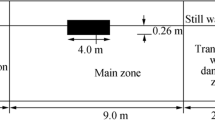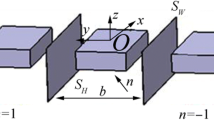Abstract
The aim of the present work is to investigate whether the degree of freedom (DOF) of a floating body has a notable effect on the maximum impact pressure due to green water on deck. The analysis is carried out for a box-shaped floating structure with a deckhouse, using experimental and numerical means to model the green water load. Green water on deck and impact on the deckhouse is generated by the impingement of a focusing wave group on a floating structure. Computations are performed using a two-dimensional constrained interpolation profile-based model solving the Navier–Stokes (N–S) equations with free surface boundary condition to deal with nonlinear water–structure interactions. The free surface is captured by a volume of fluid (VOF)-type tangent of hyperbola for interface capturing/slope weighting (THINC/SW), which is more accurate than the original THINC scheme. The verifications of the simulation through a series of model-to-model comparisons are performed in a two-dimensional glass-wall wave tank. Experimental water surface elevations, body motions and impact pressure are compared satisfactorily with the computed results for different DOFs cases. As a result, the peak impact pressure due to green water decreases rapidly with the increasing DOF.












Similar content being viewed by others
References
Buchner B (2002) Green water on ship-type offshore structures. PhD Thesis, Delft University of Technology
Cox DT, Ortega JA (2002) Laboratory observations of green water overtopping a fixed deck. Ocean Eng 29:1827–1840
Ariyarathne K, Chang KA, Mercier R (2012) Green water impact pressure on a three-dimensional model structure. Exp Fluids 53:1879–1894
Chang KA, Ariyarathne K, Mercier R (2011) Three-dimensional green water velocity on a model structure. Exp Fluids 51:327–345
Greco M, Landrini M, Faltinsen OM (2004) Impact flows and loads on ship-deck structures. J Fluid Struct 19:251–275
Faltinsen OM, Landrini M, Greco M (2004) Slamming in marine applications. J Eng Math 48:187–217
Greco M, Faltinsen OM, Landrini M (2005) Shipping of water on two-dimensional structure. J Fluid Mech 525:309–333
Monaghan JJ (1994) Simulating free surface flows with SPH. J Comput Phys 110:399–406
Koshizuka S, Tamako H, Oka Y (1995) A particle method for incompressible viscous flow with fluid fragmentation. Comput Fluid Dyn J 4:29–46
Koshizuka S, Oka Y (1996) Moving-particle semi-implicit method for fragmentation of incompressible fluid. Nucl Sci Eng 123:421–434
Sueyoshi M, Kashiwagi M, Naito S (2008) Numerical simulation of wave-induced nonlinear motions of a two-dimensional floating body by the moving particle semi-implicit method. J Mar Sci Technol 13:85–94
Shibata K, Koshizuka S (2007) Numerical analysis of shipping water impact on a deck using a particle method. Ocean Eng 34:585–593
Shibata K, Koshizuka S, Tanzawa K (2009) Three-dimensional numerical analysis of shipping water onto a moving ship using a particle method. J Mar Sci Technol 14(2):214–227
Rudman M, Cleary PW (2013) Rogue wave impact on a tension leg platform: the effect of wave incidence angle and mooring line tension. Ocean Eng 61:123–138
Khayyer A, Gotoh H, Shao SD (2009) Enhanced predictions of wave impact pressure by improved incompressible SPH methods. Appl Ocean Res 31:111–131
Khayyer A, Gotoh H (2012) A 3D higher order Laplacian model for enhancement and stabilization of pressure calculation in 3D MPS-based simulations. Appl Ocean Res 37:120–126
Hirt CW, Nichols BD (1981) Volume of fluid (VOF) method for the dynamics of free surface boundaries. J Comput Phys 39:201–225
Youngs DL (1982) Time-dependent multi-material flow with large fluid distortion. In: Morton KW, Baines MJ (eds) Numerical methods for fluid dynamics, vol 24. Academic Press, New York, pp 273–285
Xiao F, Honma Y, Kono T (2005) A simple algebraic interface capturing scheme using hyperbolic tangent function. Int J Numer Meth Fl 48:1023–1040
Yokoi K (2007) Efficient implementation of THINC scheme: a simple and practical smoothed VOF algorithm. J Comput Phys 226:1985–2002
Xiao F, Ii S, Chen C (2011) Revisit to the THINC scheme: a simple algebraic VOF algorithm. J Comput Phys 230:7086–7092
Kleefsman KMT, Fekken G, Veldman AEP, Iwanowski B, Buchner B (2005) A volume-of-fluid based simulation method for wave impact problems. J Comput Phys 206:363–393
Yamasaki J, Miyata H, Kanai A (2005) Finite-difference simulation of green water impact on fixed and moving bodies. J Mar Sci Technol 10:1–10
Hu CH, Kashiwagi M (2009) Two-dimensional numerical simulation and experiment on strongly nonlinear wave-body interactions. J Mar Sci Technol 14(2):200–213
Zhao XZ, Hu CH (2012) Numerical and experimental study on a 2-D floating body under extreme wave conditions. Appl Ocean Res 35:1–13
Liao KP, Hu CH (2013) A coupled FDM-FEM method for free surface flow interaction with thin elastic plate. J Mar Sci Technol 18(1):1–11
Hu CH, Kashiwagi M (2004) A CIP-based method for numerical simulations of violent free surface flows. J Mar Sci Technol 9:143–157
Yabe T, Xiao F, Utsumi T (2001) The constrained interpolation profile method for multiphase analysis. J Comput Phys 169:556–593
Hirt CW (1993) Volume-fraction techniques: powerful tool for wind engineering. J Wind Eng Ind Aerod 46–47:327–338
Zalesak ST (1979) Fully multi-dimensional flux corrected transport algorithm for fluid flow. J Comput Phys 31:35–62
Acknowledgments
The laboratory experiments of this study were performed during the author’s visit to RIAM at Kyushu University. Financial support from Kyushu University for the author is gratefully acknowledged. Special Acknowledgments should be given to Dr Changhong Hu. This work is jointly supported by the Fundamental Research Funds for the Central Universities (2012QNA4020), the National Natural Science Foundation of China (No. 51209184), Key Laboratory of Water-Sediment Sciences and Water Disaster Prevention of Hunan Province (Grant no. 2013SS03), and the Zhejiang Open Foundation of the Most Important Subjects.
Author information
Authors and Affiliations
Corresponding author
About this article
Cite this article
Zhao, X., Ye, Z. & Fu, Y. Green water loading on a floating structure with degree of freedom effects. J Mar Sci Technol 19, 302–313 (2014). https://doi.org/10.1007/s00773-013-0249-7
Received:
Accepted:
Published:
Issue Date:
DOI: https://doi.org/10.1007/s00773-013-0249-7




